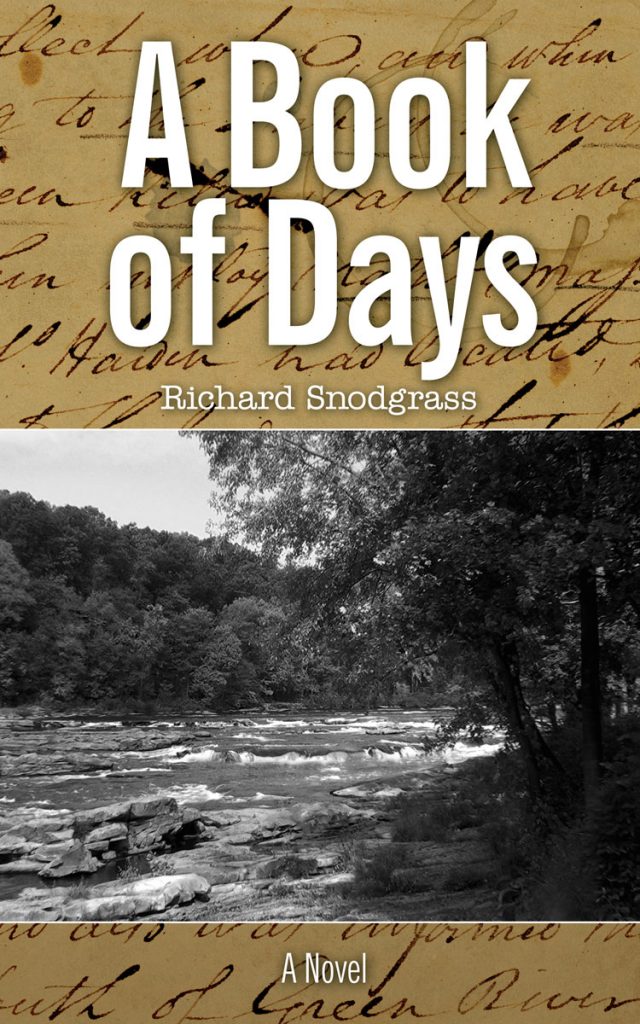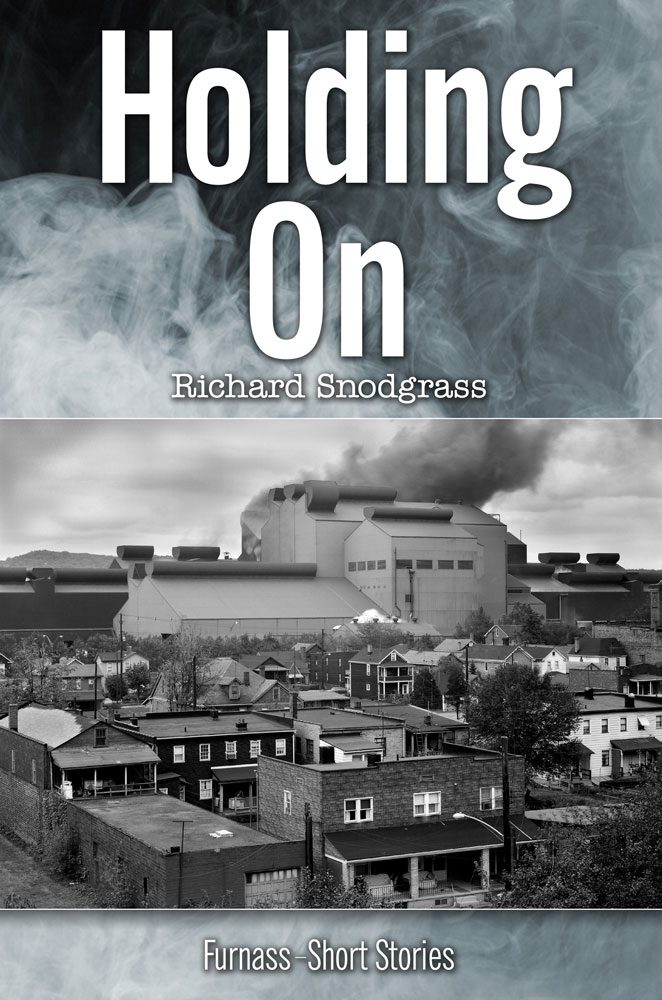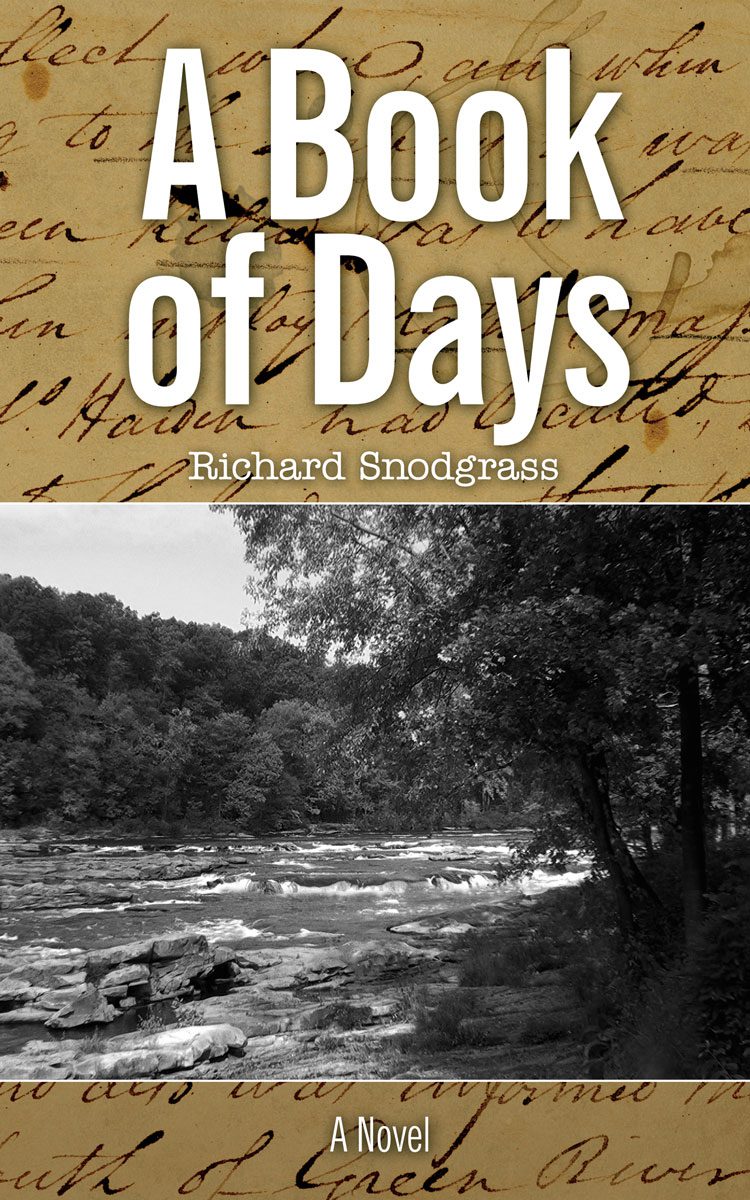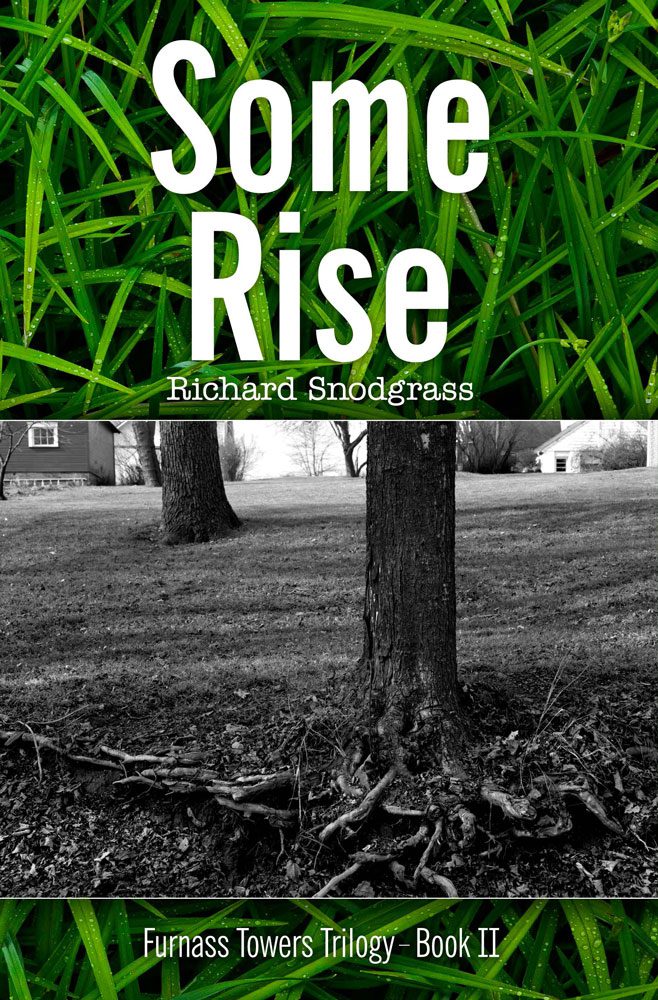A Book of Days
"A mesmerizing soldier’s tale, grippingly dramatic." - Kirkus Reviews
A BOOK OF DAYS is the story of a book, The Journal of Thomas Keating—the days when it was written, and the subsequent days when it changed the lives of those who touched it. We first see the book as a plaything for two children on a Western Pennsylvania iron plantation in the early 1800s, who use the ancient language of the book in their games of sexual awakening. We see the book in the same location in 1776, when a young woman brings the book written in Gaelic to a survivor of a massacre that occurred here, to help her understand the fate of her mother. And we see, at the heart of the novel, the writer of the book, an ensign of the Black Watch, as he seeks refuge in a blockhouse he fears is surrounded by Indians, recounting his journey upriver with a band of misfits to discover the fate of the outpost’s lost command.

Videos
Please note: The videos carry the title SHADOW OF THE VALLEY, which was the earlier title for A BOOK OF DAYS
Reader’s Guide to A BOOK OF DAYS
Summary
This unusual three-part historical novel in the form of nested stories begins in 1821, when two young siblings, Colin and Lydia, discover a book written in a strange language in an old blockhouse on their family’s property. Unable to decipher it or discern its origins, Lydia, the elder child, uses it nonetheless for an illicit game. Within this outer narrative framework is a second framework, set further back in time, in 1776. Before Colin and Lydia discover it, the book—which we learn is written in Gaelic—found its way into the possession of a secretive man who reads it aloud to a woman named Sara, translating it into English as he goes. Sara believes that the book may hold the answers to her mother’s fate. The innermost narrative framework consists of the book itself: the journal of Ensign Thomas Keating, an officer in the Forty-Second Royal Highland Regiment of Foot, sent to America in the 1760s during Pontiac’s Rebellion. Keating’s tale is a harrowing one: he and a ragtag group of troops, along with a mysterious woman named Elizabeth, trek through the Pennsylvania wilderness, through what will later become the town of Furnass, in search of the rest of Keating’s brigade, who left to find the source of a suspicious column of smoke upriver. Told from these three perspectives, the story of the journal’s life-changing influence traverses the formative decades of the American nation. A dark, absorbing read, A Book of Days raises questions of the foundations of society, morality, and human nature and unpacks the interconnected concepts of fear, trust, and love.
Questions and Topics for Discussion
- Much of the book is told from the perspective of Thomas Keating, whose viewpoint crowds out the potential counterbalancing effect of other perspectives. Did you find Keating to be a reliable narrator? What about Keating’s narration style led you to this conclusion?
- Snodgrass’s novel is similar to A. S. Byatt’s Possession in that both works are organized to contain stories within stories. How do their approaches to this distinct structure differ? What similarities can you draw between the two?
- Crows are widely known as an omen of death, and their presence is abundant in A Book of Days. Besides the obvious, what do you feel their role is in this novel? Do you think their significance evolves as the novel progresses? Does the presence of crows mean different things to different characters?
- Love, in many forms, is a central theme that runs throughout the book. How many different types of love can you distinguish in the novel? Do any of them seem to overlap or influence another? Discuss how different characters experience these emotions in unique ways.
- Discuss why Snodgrass chooses the story of two children to bookend A Book of Days. What parallels can you draw between Colin’s and Lydia’s lives and those portrayed in the other sections of the book? How do the themes of love and trust pertain to this story?
- At one point in the novel, Donald Fraser quotes Hume to his companions by asserting, “The minds of all men are similar in their feelings and operations,” which sparks a debate regarding the quotation’s meaning. What do you think the philosopher means? Does this interpretation make sense within the context of the novel?
- What do you think were Elizabeth’s true motives for her actions, especially as the journal draws to a close? Discuss the clues throughout the novel that led you to this conclusion.
- Discuss how Keating’s experiences with Jean affect his actions in America, particularly with Elizabeth. Do you think he would have reacted the same way to Elizabeth had he not known Jean in the capacity that he did?
- How did you initially interpret the news that Lieutenant Stewart was “marked for vengeance”? Did your understanding of this phrase evolve as you read? How?
- A Book of Days is the only Furnass novel without an omniscient narrator who speaks in italic passages. Why do you think Snodgrass made this decision? What does the lack of an all-knowing perspective do to the reader’s experience?
Reviews, Extra Scenes, etc.
The narration throughout the novel is graceful and patient, with great care being taken in historical accuracy, and with the colloquial accents of various characters. Scottish can be a difficult dialect to swallow when narrated poorly, but Snodgrass navigates the language well, giving it an authentic lilting beauty. He also uses these different storylines to examine morality and human nature from different angles – oppressors and oppressed, innocent and those guilty by association. These particular periods and places in history are steeped in conflict, and the novel acts like a time machine, highlighting how things change, but largely stay the same.
The characters in these three divided tales are each searching for something different, each learning about the world in a new way, with the Journal of Thomas Keating, or the Book of Love, as a constant in their changing stories. Somehow, transcending through time, the story of the Scottish soldiers of the Black Watch ignites and inspires all whom it touches, as if it is imbued with something greater, a power beyond memory.
The writing is meticulously edited and unique in voice, breaking certain grammatical norms for the sake of mood and tone. The pages are rife with memorable lines full of portent: There was so much to learn, about everything. How was anyone supposed to know it all? At some points, the novel itself reads like a journal, as though the author never expected it to be read by anyone else, which creates a sense of intimacy from the very first scene of two young children exploring their unnamed desires. Love and romance and connection can come in many forms, and Snodgrass explores this spectrum with grace.
That being said, some of the writing is choppy or interruptive, making it difficult for the prose to flow smoothly. While there is no lack of descriptive language, it is often expressed in visceral bursts of images, rather than incorporated smoothly into the scenes.
The marvel of this book, however, is the dialogue; there is rarely an exchange that feels inauthentic or forced. Some conversations are revelatory, while others only serve to strengthen the setting or develop the characters. The reliance on interaction to tell these interconnected stories is a great strength of any historical novel, as it is easy to fall back on narrating the past, rather than bringing it to life.
As a whole, this novel is complex and original, giving readers a glimpse into two rich narratives, and a third touching story broken into bookends, while simultaneously asking powerful questions about love, loyalty, innocence, and integrity.
4.5 Stars
When an ensign arrives in a colonial boundary fort to inspect its defensive structure in 18th century Pittsburgh, he finds himself thrown into the midst of the complex relationships between its occupants and the surrounding native-American tribes, with sometimes violent and profound consequences.
When ensign Thomas Keating arrives at an out-of-sorts fort outside Pittsburgh in early American colonial times, many of its soldiers have already departed for a smoking encampment down the valley. Its remaining occupants are keeping a woman called Elizabeth — who’s heavily integrated into native American culture — captive, and grappling to muddle through as they await their colleagues’ return. Keating is an educated man, and connects with the soldiers in the fort in different ways, struggling at times to unwind their hidden agendas and alliances, and to understand the surreal and at times un-soldierly scenario he’s walked into. Eventually, the occupants depart the fort and immerse themselves in a wild and dangerous area of Native American land, where differing twists of fate await them.
Author Richard Snodgrass’s text is particularly engaging in its feel for his characters and their motives, all of which feed smartly into the turns his text takes away from the predictable. At times A BOOK OF DAYS is a little plodding in its pacing, but it explores the dynamic of a number of complex relationships and uncovers depths of character, as well as making clever use of phonetics to evoke a Scottish accent and differing cultural frictions. Real-world philosopher David Hume is an ever-present undertone in the tale, a figure whose role varies from light comic relief through the language of his still-revered texts, to a past connection with the lead character and the uncertainties of his romantic life back home in Edinburgh.
Where A BOOK OF DAYS triumphs is in setting a novel in a varied and engaging environment and managing to surprise in its twists. It’s a colorful tale, a portrait of landscape and character, nuanced with unexpected depth. While the action can be notably slow-paced, it’s given punch and shade by occasional moments of dramatic violence, as well as its clever way of simultaneously ‘humanizing’ and ‘othering’ Native Americans, whose culture is portrayed in shades of light and dark, which reflect the views of the characters themselves. The core, winding narrative of the story is set within a clever throwback tale that links the events Keating wrote about in his titular book to future consequences, making for a kind of formative multi-generational mystery with plenty of unexpected angles and lots of insight. You could summarize the pertinent plot points in a handful of minutes, but the pleasure here is in taking that road, in the subtleties of language, the descriptors, and the strength of the story’s delivery.
IR Verdict: The undulating tale of a single colonial fort and its engagement with native American boundaries in 18th century Pittsburgh, A BOOK OF DAYS is a dark tale and a triumph of subtle life interactions and smart character development.
Sara—a lonesome, peripatetic 18-year-old—finds what she’s been searching for: the military outpost where she believes her mother, Elizabeth, died. A weathered, ageless man lives there—he’s cryptically known as the Seer, a hermit with stumps in place of hands. He’s in possession of a book of which she’s heard rumors—an “orderly’s day book,” written in Gaelic by Thomas Keating, a Scottish soldier and engineer dispatched to the outpost to inspect its fortifications. The bulk of Snodgrass’ bewitching novel consists of Keating’s remarkable memoir, conveyed by the Seer to Sara in a deliciously slow march into a brutal past. When Keating comes upon the outpost, Lt. Robbie Stewart, its ranking officer, has already left with 14 of his men on a mission to help the Onagonas, an ancient tribe threatened by its neighbors for planning to leave the region. But Keating does find Elizabeth Cawley—Sara’s mother—bound to a stake, apparently by orders of Stewart, with whom she may have had a romantic relationship. Elizabeth was kidnapped by Native Americans when she was 15 years old after they killed her family, and now her true identity remains muddled, an alienation she shares with Keating: “For one thing, because neither of us belongs here. In this wilderness. Barricaded in this outpost. We were brought here to this frontier by forces totally outside of ourselves. That had nothing to do with us. You in service to your king. Me because my family looked for a new life.”
With artfully executed suspense, Snodgrass unfurls this taut knot of a story. Fearful that Stewart is in trouble, Keating and the next ranking officer, Sgt. Adam MacKenzie, plan to set out in search of him. But another soldier, referred to as Black Duncan and endowed with a kind of premonitory vision, believes danger lurks nearby. Elizabeth is an intriguingly drawn character—readers will be unsure if she is sympathetic, sinister, or some complex amalgam of both. But the author’s writing style can be ponderously leaden. For example, consider Keating’s explanation to his beloved girlfriend, Jean, as to why he feels compelled to sail to America: “ ’Tis the way [philosopher] David Hume describes it. If there can be no knowledge of anything beyond experience, then I need to seek more experience. It is a matter of honor. Of honesty with myself. I need to seek the experiences that will teach me the world is real. So I know I am real. So I know what I think and feel
is real.” Nevertheless, Snodgrass does wonders with the virtue of literary restraint—why precisely the men are in such grave danger and who the Seer really is are astonishing revelations and worth suffering the sometimes-overwrought prose.
A mesmerizing soldier’s tale, grippingly dramatic.
























